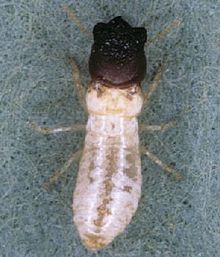Remove ads
木白蟻科(學名:Kalotermitidae)是白蟻的一個類群,俗名「乾木白蟻」。木白蟻科有21屬419種,分布於乾燥氣候的環熱帶地區。
木白蟻科形態、築巢行為和社會行為都較為原始。和其他白蟻不同,木白蟻科不需要接觸土壤也能存活,他們取食木頭並居住在其中[1],巢體結構簡易[2]。
乾木白蟻有特化的儲水機制。食物經過後腸時,後腸末端特化的腺體會從糞便中吸收水份,因此木白蟻能在乾燥的環境中存活,僅倚靠食物提供水份。木白蟻科的大顎含有鋅,可以更容易地取食堅硬的乾木[3]。
木白蟻科取食乾木的習性使他們有能力成為經濟和都市害蟲,他們能取食家具、電線桿、倉儲木材和建築物。漂流木和國際木材貿易有利於乾木白蟻擴散[4]。Cryptotermes brevis 在美國是嚴重的害蟲,分布於夏威夷、佛羅里達州及東南海岸。
木白蟻科和其他白蟻一樣都是真社會性昆蟲,但是木白蟻科的階級發育比較彈性[2][5],而且它們沒有真工蟻 (true workers),只有假工蟻 (pseudogates),假工蟻可以繼續發育成兵蟻或繁殖型[6]。假工蟻得以存在於木白蟻科中是因為白蟻為不完全變態昆蟲 (hemimetabolous),它們沒有蛹這個階段來明確地畫分未成熟的「幼蟲」與成熟的「成蟲」,它們只是暫時擔任「工蟻」階級。從外型上看,假工蟻沒有翅芽 (wing buds),而未成熟的「若蟲(未發育成熟的有翅型)」則具有翅芽[5]。
有翅繁殖型會在氣溫 27 至 38°C 的暖和晴天分飛,它們會離開木頭並朝四面八方飛去。它們會被光吸引,會聚集在燈光附近,Cryptotermes brevis 會特別偏好波長 460 和 550 nm 的光[7]。落地以後,它們四處摩擦把翅膀弄斷,繁殖型會成雙成對地築巢[8]。
木白蟻科為低等白蟻 (lower termites),低等白蟻為非正式的分類方式,腸道中除了細菌外還有共生原生動物的白蟻稱作低等白蟻,而沒有原生動物的白蟻稱作高等白蟻[9]。除了白蟻科外,其他白蟻都是低等白蟻[10]。近期支序學研究支持木白蟻科為單系群[9][11]。
木白蟻科中屬上無更高級的分類階層[4],屬與屬之間的關係研究甚少,尚未明瞭[2]。有限的分子生物學證據支持木白蟻屬 (Kalotermes ) 為木白蟻科的基群,因此木白蟻科有兩條主要分支,在木白蟻屬的分支上,木白蟻屬和角木白蟻屬 (Ceratokalotermes ) 為姊妹群,然而,這與先前依照形態做的支序樹相悖[2]。
本科包括以下属:
- Allotermes
- Bicornitermes
- Bifiditermes
- Calcaritermes
- Ceratokalotermes
- Comatermes
- 堆砂白蚁属 Cryptotermes
- Epicalotermes
- Eucryptotermes
- 树白蚁属 Glyptotermes
- 楹白蚁属 Incisitermes
- Kalotermes
- Marginitermes
- Neotermes
- Paraneotermes
- Postelectrotermes
- Procryptotermes
- Proneotermes
- Pterotermes
- Roisinitermes Scheffrahn, 2018
- Roisinitermes ebogoensis Scheffrahn, 2018[12]
- Rugitermes
- Tauritermes
- Valkyritermes Jouault, Engel & Nel, 2022
- Valkyritermes inopinatus Jouault, Engel & Nel, 2022
Remove ads
木白蟻有傢俬白蟻的稱呼,因為當其量大足以被發現時,家具早已損壞。
Remove ads
Wikiwand in your browser!
Seamless Wikipedia browsing. On steroids.
Every time you click a link to Wikipedia, Wiktionary or Wikiquote in your browser's search results, it will show the modern Wikiwand interface.
Wikiwand extension is a five stars, simple, with minimum permission required to keep your browsing private, safe and transparent.
Remove ads
